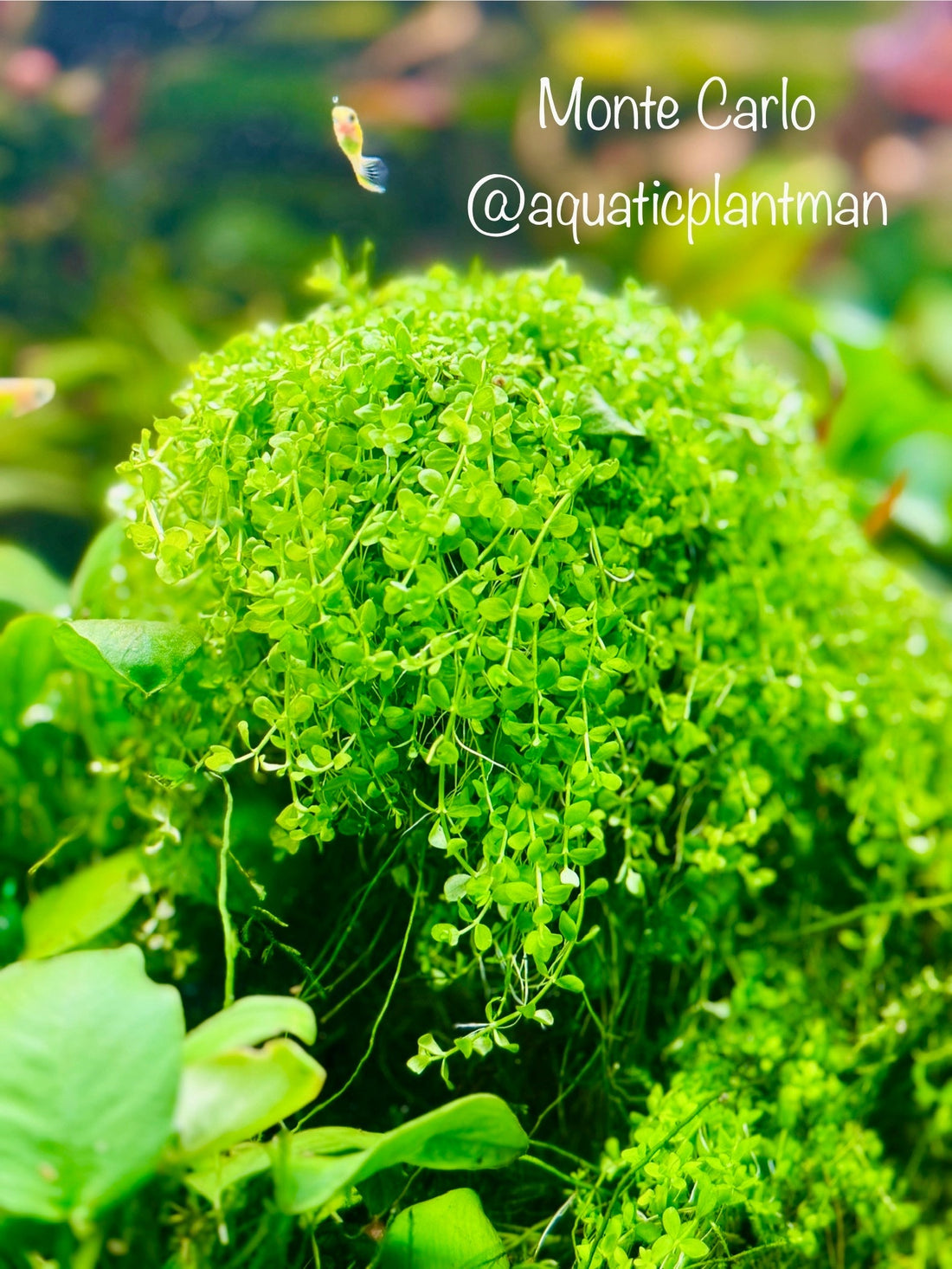Monte Carlo Micranthemum (Micranthemum tweediei): The Ultimate Guide
Monte Carlo Micranthemum (Micranthemum tweediei) is one of the most popular carpeting plants in the aquarium hobby. Loved for its vibrant green color, low-maintenance nature, and ability to create lush, soft carpets, this plant is a favorite among aquascapers of all skill levels. Whether you're a beginner looking for an easy-to-grow foreground plant or an experienced aquascaper aiming for a dense, nature-inspired layout, Monte Carlo is a fantastic choice.
In this comprehensive guide, we’ll explore everything about Monte Carlo—from its origins and growth habits to care tips, planting techniques, and troubleshooting common issues.
Origins & Natural Habitat
Monte Carlo Micranthemum originates from Argentina, specifically from the Monte Carlo region of Misiones, which inspired its common name. It thrives in moist, humid environments along riverbanks and streams, where it naturally spreads across rocks and soil, forming dense, lush mats.
In the wild, this plant grows under moderate to high light conditions, often partially submerged or along the water’s edge. Its ability to adapt to different moisture levels makes it an excellent choice for both fully submerged aquariums and paludariums.
Monte Carlo’s Growth & Appearance
Monte Carlo is a fast-growing, low-lying plant with tiny, round leaves that resemble those of Hemianthus callitrichoides (commonly known as Dwarf Baby Tears). However, unlike Dwarf Baby Tears, Monte Carlo is much easier to grow and does not require intense lighting or CO₂ injection to thrive—though both can enhance its growth significantly.
Under ideal conditions, Monte Carlo forms a dense, bright green carpet that spreads across the aquarium floor. It grows via delicate runners that branch out horizontally, covering the substrate in a soft, cushion-like mat.
Monte Carlo vs. Dwarf Baby Tears (HC Cuba)
Many aquascapers compare Monte Carlo with Hemianthus callitrichoides (HC Cuba), as both are carpeting plants with small, round leaves. However, there are some key differences:
| Feature | Monte Carlo (Micranthemum tweediei) | HC Cuba (Hemianthus callitrichoides) |
|---|---|---|
| Growth Rate | Fast | Slow |
| Light Requirements | Moderate to High | High |
| CO₂ Needs | Optional (but helps) | Required |
| Ease of Growth | Easy to Moderate | Difficult |
| Carpet Density | Dense | Very Dense |
If you’ve struggled to grow HC Cuba due to its demanding requirements, Monte Carlo is an excellent alternative that offers similar aesthetics with much less effort.
How to Grow & Care for Monte Carlo
Monte Carlo is relatively easy to grow, but for the best results, follow these care guidelines:
1. Lighting Requirements
- Moderate to high light is best for Monte Carlo to spread and maintain a compact, lush carpet.
- If lighting is too weak, the plant may grow upward instead of staying low to the ground.
- LED aquarium lights with a color temperature of 6,500K–7,500K work well.
2. CO₂ & Nutrients
- Monte Carlo can grow without CO₂ supplementation, but adding CO₂ will make it spread faster and denser.
- A nutrient-rich substrate, such as aqua soil, helps encourage strong root development.
- Supplement with liquid fertilizers and root tabs to provide essential nutrients like nitrogen, potassium, and iron.
3. Planting Techniques
- Break the plant into small clumps (about 1-2 cm in size) before planting.
- Use aquascaping tweezers to insert the roots into the substrate.
- Space the clumps evenly to allow the runners to spread naturally.
- If planting on rocks or driftwood, attach the plant using a thin fishing line or aquatic glue.
4. Water Parameters
Monte Carlo is adaptable to a wide range of water conditions:
- Temperature: 20–28°C (68–82°F)
- pH: 6.0–7.5
- Hardness: Soft to moderately hard water
- Flow: Gentle to moderate water movement helps prevent algae growth
5. Trimming & Maintenance
- Regular trimming encourages a denser carpet and prevents the plant from growing too tall.
- Use aquascaping scissors to trim Monte Carlo every 2-3 weeks, depending on growth rate.
- Remove any floating plant debris to maintain water clarity.
Common Problems & Solutions
Even though Monte Carlo is easy to grow, you may encounter some challenges:
| Problem | Cause | Solution |
|---|---|---|
| Yellowing Leaves | Nutrient deficiency | Add root tabs or liquid fertilizer |
| Melting After Planting | Transition shock | Ensure stable water parameters and good lighting |
| Algae Growth | Excess nutrients, poor flow | Reduce lighting duration, increase water flow, add algae eaters |
| Upward Growth | Insufficient light | Increase light intensity or duration |
Monte Carlo in Aquascaping
Monte Carlo is a versatile plant that works beautifully in various aquascaping styles:
- Iwagumi (Stone Layouts): Creates a bright green contrast against gray Seiryu stones.
- Nature Aquariums: Forms soft carpets that mimic natural riverbanks.
- Paludariums & Wabi-Kusa: Thrives in both submerged and semi-emersed conditions.
- Nano Tanks: Perfect for small tanks due to its compact size.
Final Thoughts
Monte Carlo Micranthemum is an exceptional choice for aquarists looking to create a lush, vibrant carpet with minimal effort. Its adaptability, fast growth, and ease of maintenance make it a go-to foreground plant for beginners and experienced aquascapers alike.
By providing the right conditions—moderate to high light, nutrient-rich substrate, and occasional CO₂—you can enjoy a thriving, beautiful Monte Carlo carpet that transforms your aquarium into a stunning underwater landscape.
Are you currently growing Monte Carlo in your tank? Share your experience and tips in the comments below!
Check out our Monte Carlo Stock HERE

